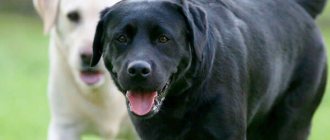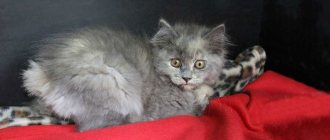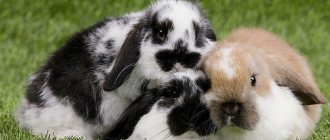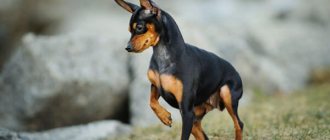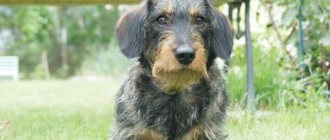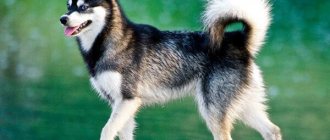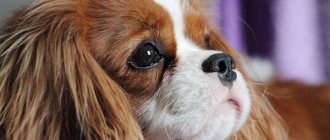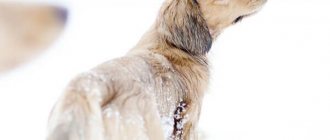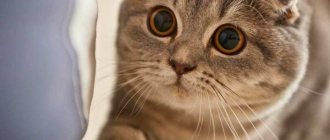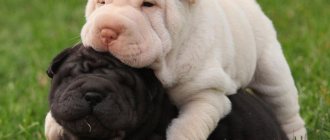Golden Retrievers were bred as gun dogs to assist hunters. Their main task was to find and bring back game shot by the owner. However, goldens, as they are also called by breeders and owners, have long been “retrained” as ideal companions, distinguished by high intelligence and selflessly loving all family members. Due to their outstanding mental abilities, excellent trainability, good-natured disposition and easy-going nature, these dogs are often used for police service, in canitherapy, and as guides for visually impaired people.
Golden Retrievers are an ideal choice for families with children of any age. Parents can be absolutely sure that the faithful dog will never offend the baby, no matter what he does. He will gladly take part in all children's pranks. In this case, the main task of adults is to explain to the child how to behave correctly with an animal so as not to hurt him. By the way, the same applies to other pets. If you already have a cat at home, get a Golden without any fears if you are sure that Murka or Barsik will favorably accept the appearance of a new four-legged family member. Have no doubt - aggression on the part of the dog is excluded.
Despite their rather large size, golden retrievers get along well in an apartment, provided that the owners are willing to provide them with sufficient exercise and exercise.
Despite all its many advantages, this breed is not suitable for everyone. If you are not ready to spend at least two hours a day outside, are not happy about active games with your pet, and are often away from home for a long time, it is better not to buy a puppy. However, this is true for almost any breed, since the rare dog loves to sit at home alone for many hours a day.
A four-legged friend is not only a joy from communication, but also a huge responsibility for at least the next ten years. Therefore, before you take him into your home, think ten times and weigh all the pros and cons to understand whether you are ready to fully care for a creature that is entirely dependent on you. If you are absolutely sure that you are ready, we invite you to take a closer look at one of the most popular dog breeds in the world - the golden retriever.
pixabay.com/jia3ep
Pros and cons of golden retrievers
Advantages of Golden Retrievers:
- Ideal for families with children, as they get along well with kids. They will steadfastly endure their antics, and with older children they will take part in active games.
- Despite their openness and kindness, these dogs are quite reserved. They won't bark for no reason.
- They are easy to train and remember commands easily. This is due to their highly developed intelligence, which places Golden Retrievers fourth on Stanley Coren's list of the smartest breeds.
- Purebred dogs with good working qualities make ideal hunting companions. They bring game and can get through even the densest thickets.
- This breed can be trained and used as guide dogs for people with disabilities.
Disadvantages of Golden Retrievers:
- They are quite mobile, so they are not suitable for couch potatoes and melancholic people. Golden needs long and active walks in the fresh air.
- They shed heavily several times a year. Therefore, for those who do not tolerate wool in the house and on their clothes, it is better to choose another breed.
- Without proper upbringing and an authoritative owner, they can become uncontrollable.
- They love water, but do not always distinguish a puddle from a lake. In rainy weather they like to wallow in the mud. Therefore, the dog should be prohibited from doing this from puppyhood and should be closely monitored during walks.
Outdoor content
Keeping a Labrador in a private home is a very good option for an energetic breed, but only if it is not a chain or an aviary. Keeping such a loving and human-dependent dog on the street is blasphemy.
The retriever feels lonely and his character changes dramatically for the worse. In conditions of social deprivation, the pet will become uninitiative and unsociable, perhaps even aggressive.
In addition to psychological abnormalities, a Labrador's coat, despite its thickness, is not able to protect it from severe frosts. In winter, the dog will constantly freeze and, as a result, get sick.
Description of Golden Retrievers
These are dogs with an attractive exterior and a moderately muscular body. But it was not only their positive character traits and beautiful appearance that made them popular. It was the pets of this breed that appeared more often than others in American films. In almost every melodrama or comedy where a dog lived in the house of the main characters, it was a golden retriever. Therefore, this dog has become an unspoken symbol of family well-being, stability and happiness.
Goldens, despite the fact that a single standard was approved for them, are divided into three types.
A Golden Retriever can be:
- English;
- Canadian;
- American.
English Golden Retrievers originated in Great Britain and are distinguished by their wide skulls and powerful paws. Their coat is lighter, as close to white as possible. It is these representatives of the breed that are popular in European countries and Russia.
American Golden Retrievers are smaller than English Golden Retrievers, but have a more graceful and elegant appearance. Their coat is darker, but its color is not as rich as that of representatives from Canada. The latter can boast of a beautiful and noble copper shade of wool.
Head
The head is large, with a wide skull. The forehead is convex, with a clearly visible transition to the muzzle. The bump on the back of the head is smoothed, the cheeks are not clearly defined. The muzzle has an elongated shape, gradually narrowing from the base to the nose.
The Golden Retriever's lips are black and well pigmented. The upper one hangs over the lower one, but does not violate the boundaries of the jaw. No teeth are visible under the lips. Small folds of skin form in the corners of the mouth.
The jaws are well developed and have a scissor bite. The teeth are large, snow-white in color. The incisors are on the same line.
The nose is well pigmented and black. The nostrils are wide and large.
Eyes
The eyes are round in shape and set deep in the skull. The look is meaningful and friendly. The iris can be colored light brown or dark brown. The eyelids are dark and fit well to the eyes. It is important that the whites of the eyes of a dog that is looking forward are not visible.
Ears
Medium length, hanging along the dog's skull. The ears are wide at the base and narrow significantly towards the end. The tip is slightly rounded. The ears are set slightly above the eye line.
Neck
The Golden Retriever's neck is well muscled, set high and of medium length. There are no folds of skin.
Frame
Adult dogs have a well-built body, with dense and prominent muscles. The back is straight, the loin is pronounced, and the withers are clearly visible. The croup has a sloping, rounded shape. The chest is wide and deep, but not excessively. The belly is tucked in, as is the groin area.
Tail
The Golden Retriever's tail is quite long, thick at the base, and tapers to a cone-shaped tip. Located below the back line. In a calm state - lowered. When the dog is excited or alert, the tail rises.
Limbs
The forelimbs are well muscled and stand parallel to each other when looking at the dog from the front. The shoulders are massive, the shoulder blades are laid back. The angle between them should not be more than 90 degrees. The pasterns are powerful, but not long, and stand at a slight angle.
The hind legs of the Golden Retriever are distinguished by well-developed muscles and are set at a great distance from each other. The hocks are set low and turned back. The paws are small and round in shape. The pads are large, the fingers are pressed tightly together, the claws are not long.
Gait
The movements of the Golden Retriever are distinguished by a good push. The gait is smooth, the hind and forelimbs move parallel to each other. The steps are long and there are no mincing movements.
Wool
The Golden's coat is quite hard, so it easily repels moisture. It is thick and long, fits well to the body. Under the guard hair there is a fluffy undercoat. Both straight and wavy coats are acceptable. The length of the hair depends on what part of the body it is located on.
The longest ones are located on the chest, ears, back of the hind and forelimbs, closer to the tip of the tail. The hair on the head and paws is quite short.
Color
The breed standard allows wool of rich golden, creamy, creamy shades. The fringes on the dog's body may be lighter than the rest of the coat. White spots in the chest area are allowed.
In the European standard, brown and red shades of coat are unacceptable when it comes to the classic English Golden Retriever.
Photos of golden retrievers of different colors
Size and weight
Golden Retrievers have a very noticeable gender identity. Males at the withers reach 60 centimeters, and their weight can be up to 41 kilograms. Females weigh much less - from 25 to 37 kilograms, and their height ranges from 51 to 56 centimeters.
Clean ears and dog manicure
The dog's ears also need to be carefully monitored and, if necessary, cleaned with a cloth moistened with boric alcohol, hydrogen peroxide or a special liquid.
Labrador's claws should be trimmed with special tweezers (nail clippers); the main thing here is not to damage the inner tissue of the claw. In a fawn Labrador it will be clearly visible, but in a dark Labrador you need to perform the procedure extremely carefully.
If your dog spends a lot of time walking on rough terrain or asphalt, then its nails will wear down to the desired length and do not need trimming.
If you accidentally remove too much internal tissue, contact your veterinarian. After all, from such a seemingly insignificant wound, the dog can become seriously lame.
Personality of the Golden Retriever
If previously goldens were used exclusively for hunting, in the modern world this happens less and less. These beautiful dogs become favorites in many families and also benefit society. They make excellent rescuers, police officers, guides and companions. In families, they can act as a nanny for a small child, and at customs they can be the main “nose” of the service. The Golden Retriever is an intelligent and easy-going dog that can be versatile with the right upbringing and training. She is distinguished by her hard work and endurance, but aggression is completely absent in her character. Therefore, goldens cannot be used as security guards or bodyguards.
Almost everyone who has deliberately made their choice in favor of a golden retriever simply dotes on their pet. These dogs have virtually no flaws. They are able to charm at first sight, using all their friendliness and charm. In addition, representatives of this breed have a phenomenal memory. If your friend showed attention to the dog or treated it to a tasty treat, the dog will not forget this and will always be happy to meet new people.
The Golden Retriever's character is quite balanced. These dogs try to “keep their face” in any situation. They avoid conflicts with any living creature in every possible way. If a person or animal does not show aggression, then the golden is always ready to become his friend. Even in critical situations, the Golden Retriever will try to resolve the issue peacefully. It is almost impossible to meet such a dog that attacked its opponent in rage.
For families with children, this breed will be a real find. Dogs will tolerate strong hugs from babies and will not be outraged if a child pulls a fur or grabs a tail. With older children, the animal will happily start games, run after a bicycle, catch a Frisbee, and chase a ball. This breed of dog is more human-oriented than others. The Golden Retriever is ready to spend all his free time from sleep with his owner and other family members. He will share with them both sorrow and joy. Such qualities allow dogs to be used in canistherapy. Animals help people who suffer from prolonged depression, once again filling their lives with color and happiness.
These dogs don't know what suspicion is. Unfamiliar people or animals arouse exceptional interest and curiosity in goldens. Therefore, do not expect that your pet will zealously protect your home and property from uninvited guests.
Features of character and behavior
Golden Retrievers are sanguine dogs. They are friendly, active, lively and cheerful. In addition, these dogs have high intelligence and learning ability. Many breeders are confident that positive energy emanates from this breed. Indeed, retrievers have practically no disadvantages.
Goldens are perfect for any person with an active lifestyle. They are considered one of the best breeds for families with children; they can become a nanny for a baby and a life partner for a teenager.
Advantages
- Golden Retrievers are friendly towards everyone, even strangers and other pets. Despite their fairly strong, well-developed muscles, these dogs never come into conflict with other animals or people.
- They are devoted to their family, will always come to the rescue, and will serve faithfully until the end of their lives . They treat children wonderfully, love to play with them and tolerate all their antics. It is difficult to make a real nurse for a baby out of a Retriever.
- In many countries, Goldens are used as healing dogs to help children with disabilities learn about the world. They have a positive effect on patient rehabilitation. Representatives of the breed are also often trained to serve as guide dogs.
- Very smart. According to canine research, these dogs rank 4th in terms of intelligence development. They easily cope with learning commands, quickly understand the owner and remember everything they want to teach them. These dogs are also easy-going and helpful, and they really enjoy helping people.
- They have a quick reaction and can take responsibility for making decisions on their own. Often, retrievers saved people from fires and water without anyone's commands. Such pets are not inclined to manipulate the owner and take a leadership position in the house, even despite their developed intelligence.
- The instincts of the ancestors are still used for familiar purposes. Thanks to their sensitive hearing and keen sense of smell, Goldens can become good hunters with proper training.
Flaws
- Such dogs are completely unsuitable for protection. They are too friendly, never attack, and do not see people and animals as a threat. Although they can fight back, this is only in emergency cases.
- They can damage things due to excessive activity. If there is a lack of attention, the retriever will attract the owner with anything, be it a torn pillow or a dug up lawn.
- This breed needs training and comprehensive education. To get a loyal, devoted and obedient friend, you will have to try hard.
Education and training
A high level of intelligence and good memory are the main advantages of golden retrievers. But this can play a cruel joke on an inattentive dog owner. If the dog does a mischief, and the owner misses this moment and does not nip it in the bud, then the situation will repeat itself again. Goldens believe that everything that is not prohibited to them is permitted. Therefore, you need to teach your dog discipline as soon as it appears in the house. The pranks that a little puppy gets up to will no longer seem cute to you when he turns into a forty-pound dog.
Like many other puppies, Golden Retrievers are quick to taste the world around them. Therefore, it is important to teach the animal the commands “Fu!” and “You can’t!” This will allow you not only to keep your furniture and shoes safe, but will also make walking outside safer. A dog that knows the commands listed above will not pick up food or other “forbidden” items from the ground.
Then you can teach your puppy basic commands such as “Come!”, “Sit!”, “Down!”, “Voice!”. The intelligence of the Golden Retriever allows training to begin at two months. When demanding to execute a command, say it in a loud and firm voice. The dog needs to understand that you are serious and that training is work, not play. After a correctly executed command, reward your baby with stroking and treats.
More complex training begins once the puppy has mastered the basic commands. If you are going to attend exhibitions and participate in competitions with your pet, then you need to accustom him to the ring, standing and touching other people's hands. After a course with a dog trainer and animal psychologist, your pet will be able to work as a guide dog or canine therapist for children with serious illnesses.
If you want to use a Golden Retriever as a hunting companion, you need to go out into the wild with him often. The dog will be able to find and bring game only if he himself sees the downed bird. However, this skill is first trained on a stuffed animal to arouse the dog's interest in the process.
At six months, the puppy can be taught swimming and obedience using a whistle. It is better to entrust this process to a professional to avoid mistakes. In a year they begin to develop the endurance that will be needed during the hunt when the dog sits in ambush. Memory training is connected to all this, since a dog cannot always find a bird solely by smell.
Hurry up, choose a box and find out what gift awaits you
Discount on pet insurance
Promo code copied to clipboard
Parenting Tips
Just like interacting with an adult dog, raising a Golden puppy brings joy and many positive emotions.
Raising an animal correctly and accustoming it to the necessary procedures and actions is not at all difficult.
The main secret of a good result that can be achieved after the animal leaves the nursery is a friendly attitude, without any aggression or screaming.
At the same time, the basic rules of upbringing that must be instilled in the animal are:
- love of cleanliness;
- calm reaction to street stimuli;
- correct relationship with the owner and household members.
From the first days, after the baby golden labrador left the nursery and appeared in the home (if he has all the necessary vaccinations), he can be taught to go to the toilet outside.
With proper upbringing, a golden dog should ask for a walk from the age of six months.
It is important to note that the owners will need patience here. Do not physically punish the animal under any circumstances: love and understanding will bear fruit.
If the kennel is not responsible for the availability of vaccinations, it is important to ensure that the puppy has the opportunity to go to the toilet in the house.
The following will help you properly set up a corner for your golden labrador::
People are concerned about hygiene in their own home, so they believe that after bringing a Golden into the house, it is necessary to remove all carpets.
This decision is not correct, since at a young age the ligaments and tendons of a Labrador are not particularly strong.
By teaching a baby to “walk” on tiles or linoleum, the owner can cause considerable harm to the pet’s health.
Constant tension in the leg muscles of an animal at this age increases the risk of developing certain diseases. The result of such actions is dysplasia.
To avoid possible problems, experts recommend covering the space reserved for the animal’s habitat with inexpensive carpet, porous, or rubber mats that can be easily washed and cleaned.
When teaching your Golden Labrador to hygiene, you need to know that small retrievers are not protected from infections.
Diseases and the negative effects of microorganisms can be avoided by keeping the house clean. For example, you cannot leave street shoes in the hallway that an animal can reach.
You cannot leave food brought from a store or market in the accessible vicinity. You should also not allow him to chew on objects and toys of other pets living in the house. When taking your golden dog out for a walk, you should not drive it through puddles and mud.
Your Golden Labrador puppy needs frequent but short walks outside.
However, you need to ensure that your pet does not become overtired. Free running and the opportunity to frolic, as well as leisurely exploration of park paths and lawns, will be beneficial.
As the dog grows, it is recommended to walk the dog for about an hour and a half in the morning, up to 20 minutes in the middle of the day and a few minutes in the evening.
Do not force your Golden to run for hours at a time, this is not good for your Golden Retriever.
Keeping Golden Retrievers
Today, in order to throw out their energy, representatives of this breed no longer need to run through the forest after shot prey. Hunting can easily be replaced by long walks in the park, games and physical activity. A private home with a spacious area where he can run freely in the fresh air is perfect for a Golden Retriever. But you shouldn’t put your pet on a chain; he definitely won’t appreciate it. This restriction of movement will negatively affect the dog’s physical and psychological health. She will become despondent, sad and miss her owner. Golden needs to be a companion and friend, so it is better for him to live in a home with his family.
Keeping such a dog in an apartment environment is quite difficult. This is an active and energetic dog, and a small area will hold him back. But this disadvantage can be compensated for by active walks, which should take place at least twice a day and last several hours.
Most goldens do not tolerate separation from their owner well. Therefore, when he leaves for work, the animal can throw out its bad mood on surrounding objects. The biggest punishment for this dog is loneliness. If you are a careerist and only come home to spend the night, then it is better to abandon the idea of owning a golden retriever.
If you want your dog to remain healthy and energetic for a long time, then do not let children saddle him like a horse. The weight of the child can cause the animal's back to bend and bend. The puppy should not be stroked on the head with the palm of his hand and a collar should not be put on him through it. This way the ears may be positioned incorrectly.
One of the main problems in keeping a Golden Retriever can be its coat. When it's time to shed, your pet's fur will literally be everywhere. Even if you brush your dog several times a day, this will not improve the situation. There are two options to solve this problem. Either give up this breed, or put up with heavy shedding. If you choose the second option, stock up on brushes, rolls of adhesive tape for cleaning clothes, and a powerful vacuum cleaner. For combing wool, a comb with metal teeth rounded at the ends, as well as a mitten for collecting hair, is suitable. To get rid of excess undercoat, you will need a furminator or slicker brush. Get your dog used to brushing from an early age to prevent it from causing inconvenience in the future.
Between shedding coats, your Golden Retriever's coat is fairly easy to care for. A few brushings per week is enough. The dog should be bathed no more than once a month, and after this procedure the animal’s fur can be shortened slightly.
These dogs have practically no problems with their eyes and ears. Therefore, they can be examined for inflammation only occasionally. These parts of the body are cleaned with a cotton swab, which is moistened with a special lotion.
Teeth should be brushed using a regular toothbrush or finger brush, but using pet toothpaste. If a stone has formed, it is removed with ultrasound. To prevent plaque, your dog can be given special dental bones to chew on. They gently massage your gums and clean your teeth.
Golden care
Like any other animal, a retriever requires special care. Due to long hair, dogs often develop mats and bald spots. If combing is not done in a timely manner, a rash may also appear due to constant humidity and overheating.
Grooming
To comb your retriever, it is best to use a metal comb with two types of teeth. The long teeth of the comb do a good job of combing out tangled hair, while the short ones allow you to comb the undercoat efficiently. It is also very convenient to remove hair with a rubber glove. To do this, you just need to stroke the dog in the direction of hair growth. Caring for a mature Golden Retriever involves regular bathing. To wash wool, you should use only special shampoos for dogs. Washing retrievers with human shampoo can cause coat deterioration and hair loss.
Bathing
It rains very often during the spring-autumn period. Despite bad weather, the dog needs regular exercise. When it rains, goldens usually wear special waterproof overalls, but even in them the tail and paws get dirty. Frequently washing dogs with shampoo is not recommended, so they are bathed under running water. If you still need to wash with shampoo, then it is better to give preference to the following manufacturers:
- TropiClean.
- Rolf Club.
- 8in1.
- Phytoelite.
- Beekeeper.
It is better to wash retrievers with shampoo no more than once a week. Before the exhibition, groomers recommend additional use of conditioner.
Golden haircut
All breeds, including retrievers, have their own inimitable appearance. A breed haircut can highlight the advantages and hide the shortcomings of the exterior. Since the Golden is a rather difficult breed to groom, it is better to contact a professional groomer to carry out all manipulations with the coat. If, nevertheless, the owner decides to do the haircut himself, then he should know a few basic rules:
- Only clean dogs are cut.
- The retriever's coat should be well combed.
- All haircuts are performed only with thinning scissors. The exception is the area of the paws and tail. To trim these areas, you will need small scissors with rounded tips and large ones with straight blades.
- While grooming, you also need to trim your nails.
It is better for a novice owner to learn how to care for a Golden Retriever from the first days of the puppy’s life in his home. Early training of the dog to the groomer's table and the necessary procedures will make life easier for the owners and the dog.
Nutrition
To keep your dog healthy and active, it is important to choose the right diet. The best option would be industrial wet or dry food. It contains all the vitamins and minerals necessary for the animal. The industrial diet is perfectly balanced. Therefore, you don’t have to worry about your pet not getting enough of certain nutrients.
If possible, it is better to choose premium and super premium food for your golden retriever. They contain animal fat and protein, natural meat, grains and vegetables. Such diets are enriched with vitamin complexes. Cheaper foods are made from offal and also contain little protein and a lot of carbohydrates.
Golden Retriever food pellets should be large in size. The dog will chew them, which will prevent overeating and quickly swallowing food.
Golden puppies are fed five times a day until they are four months old. When animals reach five months of age, they are transferred to four meals a day. After six months, dogs eat three times a day, and after eight months, like adult dogs, twice.
Own house
Let's move on to building the booth. Its purpose is to protect the animal from cold and wind, so carefully ensure that there are no cracks. When choosing the size for a house under construction, you should take into account the dimensions of the dog. The Labrador should fit there with its paws extended.
Suitable materials are brick or stone. A booth made of wood should be covered with tin on top. This will insulate the building and give it reliability. It is better to raise a floor made of boards above the ground so that there is an air gap for ventilation. The door is made as desired. Instead, it is quite possible to use a piece of felt, which is attached to the upper part of the opening.
Another important element is the size of the entrance, which fully corresponds to the height of the dog. When entering the booth, the dog should not arch his back. Typically, Labradors rarely suffer from such a defect, but its artificial development should still be excluded. And in order to make it more convenient to sweep garbage out of the house, it is better not to make any border on the floor before leaving.
When building a booth, you can quite use your imagination and make it yourself.
Golden Retriever Health
Unfortunately, Golden Retrievers are a sickly breed of dog. Therefore, they can often be seen together with their owners in veterinary clinics. The most common diseases that goldens suffer from are mentioned in every reference book. Common pathologies include hip dysplasia, which is common in many large dog breeds, and retinal degeneration.
In addition, golden retrievers are susceptible to a dozen more pathologies, if not more. They are more often diagnosed with malignant tumors and diseases of the cardiovascular system. They are prone to allergies, hypothyroidism, atopic dermatitis and other unpleasant and dangerous ailments.
Golden Retrievers become overweight easily. Many may think that this problem is not so bad. But obesity causes serious health problems. Excess weight significantly reduces the life expectancy of animals and also has a negative effect on joints. Therefore, in old age, fat dogs develop arthritis.
It is important not to miss disease of the teeth and gums. Inflammation or an abscess can become an impetus for the development of infection throughout the body. And without timely treatment this can be fatal.
Summing up
It is better to begin caring actions as early as possible so that the pet gradually gets used to them. Most retrievers move to a new home at about 8 weeks of age, at which time you can introduce the baby to the necessary items and procedures. Put the first collar on him (soft and for a short time at first), show him the leash, let him sniff the brushes for his body and teeth, and the sponge with which you will wash him.
The contact should be unobtrusive - the puppy’s nervous system is still developing, it is sensitive to touch, it is unusual for it. If he is afraid or does not want to brush his hair, do not insist and postpone grooming until later: it is important that the dog does not have negative associations associated with the procedures.
- Retriever
- care
If you find an error, please select a piece of text and press Ctrl + Enter.
History of the breed
The main reason for the emergence of the Golden Retriever breed was the love of English aristocrats for hunting. In the nineteenth century, rich blue-bloods spent all their free time shooting wild ducks. To do this, they needed faithful and dexterous assistants. At that time, hounds were already actively used for hunting. The question arose about the need for a dog to search for and present wounded birds. It was this demand that provoked the emergence of the Golden breed, which first appeared in Scotland.
The emergence of the Golden Retriever breed is usually associated with the name of Dudley Marjoribanks. This lord, originally from Scotland, was known for his love of dogs. It was he who became the “father” of the breed, which was not afraid of water, could easily get through a dense thicket, find and bring game.
Photo of a golden retriever
What kind of blood flowed through the veins of Marjoribanks' dogs was long kept secret. But in the mid-twentieth century, notes from his books were published. And it became known to the whole world that goldens owe their origin to Labradors, retrievers, spaniels and bloodhounds. The very first offspring were from a tweed water spaniel and a straight-coated retriever, which had a yellowish color.
At the beginning of the last century, Goldens managed to become popular in many European countries. Then they appeared in America and Canada. Moreover, in these countries a special breed standard was formed. Golden retrievers did not make it to the Soviet Union. They were brought to Russian territory after its collapse. The first Golden appeared in our country only in 1991.
Important sense organs
A dog's nose is its main asset. This is a guide, a working tool, and an assistant for obtaining food. By its appearance, you can determine the well-being of your pet. If the nose is warm and dry, this indicates unsatisfactory condition, and if it is wet and cold, the dog is in excellent shape. To prevent your pet from catching a cold, you need to protect it from hypothermia.
On the muzzle there are special hairs called vibrissae. This is the main organ of touch in an animal. They help recognize the road and find objects. But over time, the vibrissae can become dirty, so they need to be cleaned periodically. This should be done with a soft cloth moistened with water. But you should not use alcohol or strong-smelling solutions.
A healthy Labrador does not have any discharge from the eyes. Only after sleep may mucous droplets appear in the corners, which should be removed with a dry cloth. Sometimes dirt can get into your eyes, leading to inflammation. Then it is recommended to wash them with chamomile solution.
Photos of golden retrievers
Walking and exercise
The need for movement is in the Labrador's blood. He was bred for hunting. Moreover, it does not work like a husky - at a distance from the hunter, but very close to the person. Contact with the owner is important for the breed. Active walks provide your pet with such closeness.
It’s not enough for Labru to walk sedately through the park on a leash. Outdoor games are what a Labrador Retriever needs to stay healthy. The breed description contains this information. If there is no suitable company for your pet in the area, the owner should take on the role of play partner.
Loads need to be dosed. There is no need to exhaust a small puppy during walks so that he falls dead as soon as he crosses the threshold of the apartment. A growing pet cannot move as actively as an adult dog. Gradually the load is increased.
The ideal type of exercise for a puppy is swimming. All muscle groups work, while the load on fragile joints is not significant. It is useful for dogs to move in shallow water. In winter, ponds will be replaced by snowdrifts. Driving through deep snow is a good alternative to swimming.
Who is this breed suitable for?
The Golden Retriever is suitable for active owners who are willing to devote a lot of time to walks with their pet. It should not be owned by those who are rarely at home, or by older people. A dog will feel good in an apartment only if it has frequent and long walks outside. The ideal place for a dog to live would be a house with a large surrounding area.
If you are pedantic and do not tolerate wool on your clothes, then Golden will not be the best choice. Allergy sufferers may also have problems with this dog.
A representative of this breed will fit perfectly into a family with children. He will be both a nanny and a friend for them. The Golden Retriever also gets along well with other animals.
This dog is also suitable for those who are interested in hunting. To demonstrate its working qualities, the Golden needs professional training.
Possible diseases and methods of treating them
Fortunately, Golden Retrievers are in very good health. But any dog can get sick if it is not provided with proper care. It is better not to take a young representative of the breed outside until he has received all the necessary vaccinations.
The ideal option is to keep it at home for up to six months. If an unvaccinated purebred dog begins to walk on street soil and come into contact with other dogs, he can become infected and even die. Don't let this happen.
He has no specific diseases; even joint dysplasia appears extremely rarely in golden retrievers. But the dog’s health can suffer due to parasites. Helminthic infestation leads to intoxication of his body. The animal may begin to vomit, defecate frequently, and become less active.
Another clear symptom of his intestines being damaged by worms is itching in the anal area. A sick dog will always try to scratch itself to get rid of the discomfort. Therefore, every year give her deworming medication prescribed by your veterinarian. This is necessary for prevention. It would also be a good idea to regularly treat your fur for fleas.
Famous owners
Golden retrievers are distinguished by their attractive appearance, kind and cheerful disposition, and friendliness. It is not surprising that many celebrities preferred this breed.
Golden was the favorite dog of US President Gerald Ford. The dog's name was Liberty. The President adored his pet and even threw parties at the White House in honor of his birthdays. Ford was often criticized for this in the press.
Famous film actor James Belushi had a golden dog named Memo for fifteen years. Celebrities such as Bradley Cooper, Pamela Anderson and Jackie Chan also own golden retrievers.
Getting rid of parasites
Another problem is worms.
Roundworms are found predominantly in young dogs. They are usually born with them already in their stomach. Therefore, it is better to start treatment in the first two months of the pet’s life.
Tapeworms infect adult animals. The carriers of these worms are rodents and fleas. You can guess the presence of these worms by finding white eggs that look like grains of rice in the feces. To prevent infection, it is necessary to carry out antihelminthic measures once every 3-4 months. The following products are effective: DrontalPlus, Kanikvantel, Milbemax.
To prevent your Labrador from contracting infectious diseases, it is necessary to vaccinate on time:
- from rabies for the first time every 3 months and then every year;
- plague at two months;
- parvovirus at two months;
- leptospirosis at two months;
- hepatitis at two months.
Further vaccinations should be repeated every year, and after 6 years - once every two years. Please note that 2 weeks before any vaccination, the dog must be treated for worms.
Write your opinion in the comments.
If you liked the article, like it and share it with your friends.
How to choose a puppy
To purchase a purebred dog, you should not look for a dog through dubious advertisements on the Internet or buy a puppy second-hand on the market. It is better to choose a well-known nursery or breeders with extensive experience and good reviews.
Before the meeting, study all the information about the breed standard. You can go with a professional dog trainer who can help you make the right choice.
If you are going to go hunting with your dog, you should buy a puppy from working parents. For those who want to take part in exhibitions and competitions, a show-class animal is suitable. In this matter, the deciding factor will be who the puppy’s parents are. The more awards they have, the more likely it is that their baby will also be successful.
From its parents, the puppy inherits not only working qualities and exterior features, but also character traits. Therefore, it is important to get to know the mother and father of your future pet. If the seller does not want to show them to you, this is a reason to refuse the purchase. After all, this means that not everything is in order with the puppy’s pedigree.
If you want to buy a dog that will be part of your family and become a pet, then give preference to females. They are more flexible and are more attached to their owners. Males of this breed are very charismatic, but they need a confident owner who can become a leader for the dog. Boys are more active and talented in hunting.
It is noteworthy that the temperament of American and European golden retrievers differs. This fact should definitely be taken into account when choosing a puppy. Dogs from America are more energetic and show their emotions more clearly. While European representatives of the breed are distinguished by their calm character and patience.
In well-known breeding kennels, golden retrievers are kept in good conditions. The puppies are well-fed, healthy, cheerful. All babies must have a pedigree, a passport with vaccinations and marks on treatment with anthelmintic drugs.
Common Teaching Mistakes
When practicing skills, you need to ensure that the trainer’s actions are logical and understandable to the dog. Typical mistakes when learning:
- the requirement to strictly follow orders from a tired animal;
- pronouncing a command (for example, “sit!”) after physical impact (if it is used), and not before it;
- aggressive intonation, raised voice, impulsive gestures;
- repetition of the same pose when giving commands (the initial conditions need to be changed);
- practicing several skills mixed;
- change in word form;
- incorrect or uncertain intonation (the command should be given calmly, clearly, peremptorily, but without anger in the voice);
- non-compliance with the training schedule (you need to exercise daily, preferably more than once, but in a gentle manner in order to maintain and fuel the puppy’s interest in learning);
- neglect of praise and rewards (it is better to overdo it with enthusiasm for the pet’s success than to under-reward it).
Photos of golden retriever puppies
What to feed?
Labradors are not picky eaters at all. They eat everything that gets into their bowl or comes along the way. This does not mean that their nutrition should not be given attention. Quite the contrary, if you want a healthy and active dog that is not obese, take your pet's diet seriously. Find out what to feed your Labrador before he arrives in the house.
Ready-made rations
Puppies and adults can eat prepared or natural food. Ready-made diets have two important advantages: they do not need to be prepared, and they are balanced in composition. However, you only need to buy food of at least the “Premium” class. Those who save on feed later spend on veterinarians.
Ready-made diets are selected based on the age of the dog. If the pet has gained excess weight, it is transferred to a diet diet. There are special diets for weakened individuals and lactating bitches. Menus have been developed that Labrador puppies will enjoy. Feeding is organized according to the instructions on the package.
Puppy diet
At first, the puppy should eat food that is familiar to him. Ask the breeder what your pet ate and follow their recommendations. After a week, you can gradually switch the baby to another food.
You need to immediately teach the puppy to eat in one place and at the same time. If your baby hasn't finished eating, remove the bowl with the leftovers. Just don't put away the dishes with water. It should always be freely available. And make sure the portion is not too big for a small pet.
Depending on their age, puppies are provided with the following feeding regimen:
- up to 2 months – six meals a day;
- up to 4 months – five times a day;
- up to 6 months – four times a day;
- 7–12 months – three times a day;
- Dogs after a year eat twice a day.
Adult dog diet
If the owner chooses natural feeding for his pet, he needs to decide whether he will heat-treat them. The answer to this question depends on many factors. In each individual case, it is better to consult a veterinarian. In any case, the diet should be balanced in proteins, fats and carbohydrates.
For a Labrador, it is important to maintain the following proportions:
- meat products 10–15 g/kg weight;
- carbohydrates – 3–5 g/kg;
- fats – 1–2 g/kg of pet’s weight.
Sources of protein include meat, offal, fish, dairy products, eggs. Carbohydrates - porridge and crackers, fats - dairy products and vegetable oil.
- Meat – suitable beef, chicken, turkey, horse meat and lamb, offal. It can be given either raw or boiled. Some breeders combine raw and boiled meat techniques. The product is cut into pieces, the fat must be trimmed off. Scars are useful by-products. The liver, kidneys, heart, udder are boiled and also cut into pieces.
- Fish is mainly sea fish. There should be no bones in it. If you decide not to boil it, provide your pet with a set of antihelminthic measures.
- Cereals are sources of carbohydrates. It is not recommended to take pearl barley, as it is poorly absorbed. And oatmeal can cause allergic reactions. Instead of cereals, you can give crackers made from black bread.
- Dairy products, eggs - it is not advisable to give milk to dogs; it is better to replace it with lactic acid products. Eggs produce only yolks. They are mixed raw with vegetables or cereals. Cheese and cottage cheese are suitable, not sour and not spicy.
- Vegetables - cabbage, carrots, beets, pumpkin, zucchini are given in chopped form. Add butter or sour cream to them.
We must not forget about vitamins and mineral supplements, especially in winter. Dogs need them daily.
What should you not feed your Labrador?
The following should not be included in the diet of adult dogs and puppies:
- hot (immediately from the stove) and too cold food;
- salty, spicy, fatty, smoked;
- baked goods made from wheat flour, pasta, legumes, potatoes, peas;
- sweets, sugar;
- sausages and frankfurters;
- fatty lamb and pork;
- bones (especially tubular ones);
- spices and seasonings;
- spoiled products.
Prices for golden retrievers
The most inexpensive dogs will be pet-class puppies. Their cost varies from 20 to 25 thousand rubles. The reasonable price is due to minor flaws in the exterior, which are difficult for a non-professional breeder to discern. They do not affect the character of the dog or its health in any way. Pet-class dogs will become excellent friends and family members. If you are not going to build a golden retriever’s “career” at shows, then you can save money and buy such a puppy.
To participate in competitions you will need a show class dog. You will have to pay about 50 thousand rubles for it. Puppies from overseas parents are the most expensive. They are purchased for further breeding of the breed. The price of such dogs ranges from 70 to 80 thousand rubles.
Retriever dog training
A dog of this breed is considered one of the smartest, but even with training you will need patience and all kinds of encouragement in the form of treats. Since the retriever is a sociable dog, you should focus on commands such as sit, wait, next to and lie down. Don’t worry if you don’t succeed the first time - constant training and attention will make the animal docile and well-mannered.
Cinematographers all over the world love retrievers, because the camera loves them, they easily follow commands and do what is required of them. This is confirmed by many films with their participation, for example, “The Lovely Bones” or “King of the Air”. By the way, it is the second film that can be recommended for viewing to those who have not yet decided on a purchase, since Golden’s grace, strength and intelligence can conquer at first sight.
Photo gallery
When choosing a puppy, it is important to remember the large size of the golden labrador, which dictates its own conditions in maintenance and care. Although if you look at these cute babies in the photo, you won’t even think about what size an adult dog will be.
Brief characteristics of the breed representatives
| How long they live: 10-12 years. | The sizes of adults are: Males:
Bitches:
How much does a puppy cost:
|
Who are Golden Retrievers Suitable for? | Young active people leading a healthy lifestyle. Families with children. For those who are comfortable with dog hair indoors. Not suitable for: people with allergies to wool, the elderly, and those who cannot provide their pet with regular long walks and quality care. |
Who is better to choose: a male or a female? | If you need a dog as a companion, it is better to purchase a female. She is more balanced, obedient, calm, and quickly gets used to her owner. It will be easier to control it. If a Golden is needed for hunting, it is better to take a male. It should be taken into account that working dogs feel uncomfortable in apartment conditions and sometimes show aggression towards other pets. |
Can I keep it in an apartment? | Recommended living conditions are a country house and a garden with a secure fence. You can keep it in an apartment, but you need regular long walks in the park and physical activity. |
What is better to feed a retriever: dry food or natural food? | Depends on the capabilities of the owner. However, you cannot mix types of feeding: industrial feed of the highest category is completely balanced and contains all the substances necessary for normal life. Adding other foods to your diet upsets the balance. In addition, when eating industrial feed, certain enzymes are produced that are not able to digest natural food. |
Is it easy to train? | These are very smart dogs and are highly trainable. It is important to start training as early as possible. However, one must make allowances for the tendency to mischief and stubbornness. To maintain your puppy's interest, classes must be dynamic. |
How are retrievers used? | When hunting, goldens lift the bird onto their wing and bring back the prey they have shot. Compared to other hunting breeds, they are much better at searching for game in the thickets. Since their mouths are soft, they do not spoil the bird. Due to their adequate and quick reaction and excellent sense of smell, they are used as guide dogs for people with visual impairments, and also as rescuers. In addition, they take part in search activities. |
Advantages:
- good-natured, peaceful;
- not aggressive;
- obedient;
- smart, easy to train;
- hardy,
- decisive;
- bark a little;
- have a stable psyche;
- love children;
- get along well with cats and other pets.
Flaws:
- Regular grooming is required;
- physical activity is required;
- are unable to perform the functions of a defender or security guard;
- love to eat, because of this they are prone to obesity;
- cannot be kept in an enclosure, on a chain (due to its high social orientation).
What is the difference between a Golden Retriever and a Labrador?
| Differences between a Golden Retriever and a Labrador | Retriever | Labrador |
| appearance | more elegant, larger paws, tail with a pendant (feather shape), like a setter | simpler and more massive, larger head |
| color | only gold (in various variations) | red, black, brown, chocolate |
| coat | longer and softer | has a coating characteristic of waterfowl dogs |
| character | more wayward | easier than a retriever |
| reactions to commands | approaches the issue with caution | performs without delay |
What actions harm the animal?
In the process of raising a golden Labrador, it is important to adhere not only to the rules, but also to take into account contraindications.
To achieve good results after the baby has left the nursery, you need to remember the following nuances:
- walks of more than 4 kilometers are harmful for the baby;
- You cannot be forced to run on a leash behind a bicycle;
- do not force your pet to jump over obstacles;
- do not allow them to play with large dogs;
- It is forbidden to pick up an animal by its paws;
- It is forbidden to lift the animal under the chest (only supporting the butt);
- it is important to ensure that the baby does not jump from high surfaces;
- It is not recommended to allow the animal to sleep on a chair, master’s bed or other places not intended for this purpose;
- arranging a place for an animal under a radiator in an apartment threatens hair loss and a deterioration in general health.
In addition, you should make it a rule that the puppy cannot be fed from the table.
Meals must be timely and only in a specially designated place. Avoid snacking.
Diet
Meats include lamb, beef, turkey, and rabbit. Pork and poultry bones are not allowed. It is advisable to add pumpkin, carrots, cabbage, beets with herbs, and buckwheat to the food. By-products are possible in small quantities.
Adult dogs need two meals a day and fermented milk products; puppies are fed more often, always including milk in the menu. Feeding occurs only after walking. You can use premium dry products.
Possible diseases
This dog is by no means in poor health. The dog is hardy and strong, but even such a strong dog can have ailments characteristic of its breed. Dog handlers distinguish two diseases - eye and joint (different types of dysplasia). In addition, retrievers are susceptible to endocrine and skin diseases.
Mother golden retriever with puppy
As for eye diseases, the leader is retinal degeneration, which can be either hereditary or acquired during life. The first option is more common, and the second is, as a rule, a complication after retinal detachment, cataracts, glaucoma, infections and even poisoning.
To correctly diagnose this disease, laboratory tests are performed. Outpatient type of treatment is allowed. The danger lies in further complications, including loss of vision. As a preventive measure, you need to maintain the balance of taurine in the body.
Another characteristic ailment of the breed is von Willebrand disease, which is usually inherited. Associated with disruption of synthesis, which is involved in platelet-vascular hemostasis.
You can suspect it by gastrointestinal bleeding, bleeding gums, blood from the nose and genitals. Surgery is required, and blood thinners such as aspirin are contraindicated for the dog.
Among hormonal diseases, hypothyroidism is not uncommon - insufficiency of thyroid hormones, due to which neuropsychic activity is depressed, the dog swells, and bradycardia is possible.
Experts note that females get sick 2.5 times more often than males. Hypothyroidism can lead to cretinism. The disease can be suspected by symptoms such as lethargy and depression in dogs, physical weakness and obesity, decreased sexual activity, and damage to fur.
Wounds may take a long time to heal. Surgery is rarely required; outpatient treatment is sufficient. At the same time, it is important to exclude fatty foods from the diet, and for retrievers suffering from obesity to adjust their body weight. With diligent treatment, positive prognosis is possible, but the animal will be tied to hormonal medications for the rest of its life.
Skin diseases include atopic dermatitis, a chronic disease with side effects such as itchy skin. Allergens that provoke a surge in reactions can be plants, the hair of other animals, and dust. It is important to maintain a cool temperature not exceeding 22 degrees, as well as high humidity in the room - from 40 to 70%.
